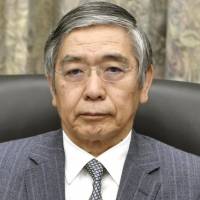Bank of Japan Gov. Haruhiko Kuroda on Friday suggested the central bank may delay the timing for hitting its 2 percent inflation target by a year to in, or after, fiscal 2018.
That means it may not be achieved during his term, which ends in April 2018.
"I personally think it is possible" the central bank will change the schedule for achieving the 2 percent goal at the next Policy Board meeting, Kuroda said. The BOJ's current time frame for achieving the inflation target is sometime during fiscal 2017.
The governor sees little need to decide on additional monetary easing measures at its next two-day policy meeting through Nov. 1.
"It is difficult to think" the BOJ will soon change its target of appropriate short-and long-term interest rate levels, Kuroda said during a Diet session, adding Japan's economic situation is not so different from late September, when the BOJ held its previous policy meeting.
At the September meeting, the BOJ decided to shift its policy target to the yield curve instead of quantitative easing and money supply.
Since then, the bank has modified the framework of its bond-buying program to keep the yield of the bellwether 10-year Japanese government bond at around zero percent, while leaving its negative interest rate unchanged at minus 0.1 percent.
The BOJ has also promised to continue expanding the monetary base until year-on-year changes in consumer prices exceed 2 percent in a stable manner, retaining its target of ¥80 trillion ($768 billion) in JGB purchases per year.
Kuroda has failed to break the nation's deflationary mindset in his 3½ years as BOJ governor. While he has cited the slump in oil prices as the main reason for not reaching his 2 percent inflation goal, his own policy choices may have added to the challenges.



